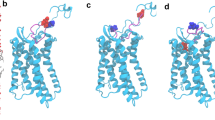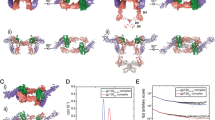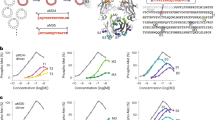Abstract
Dimerization of the erythropoietin (EPO) receptor (EPOR), in the presence of either natural (EPO) or synthetic (EPO-mimetic peptides, EMPs) ligands is the principal extracellular event that leads to receptor activation. The crystal structure of the extracellular domain of EPOR bound to an inactive (antagonist) peptide at 2.7 Å resolution has unexpectedly revealed that dimerization still occurs, but the orientation between receptor molecules is altered relative to active (agonist) peptide complexes. Comparison of the biological properties of agonist and antagonist EMPs with EPO suggests that the extracellular domain orientation is tightly coupled to the cytoplasmic signaling events and, hence, provides valuable new insights into the design of synthetic ligands for EPOR and other cytokine receptors.
This is a preview of subscription content, access via your institution
Access options
Subscribe to this journal
Receive 12 print issues and online access
$189.00 per year
only $15.75 per issue
Buy this article
- Purchase on Springer Link
- Instant access to full article PDF
Prices may be subject to local taxes which are calculated during checkout







Similar content being viewed by others
Accession codes
References
Watowich, S.S., Hilton, D.J. & Lodish, H.F. Activation and inhibition of erythropoietin receptor function: role of receptor dimerization. Mol. Cell. Biol. 14, 3535–3549 (1994).
Blau, C.A., Peterson, K.R., Drachman, J.G. & Spencer, D.M. A proliferation switch for genetically modified cells. Proc. Natl. Acad. Sci. USA 94, 3076–3081 (1997).
Livnah, O. et al. Functional mimicry of a protein hormone by a peptide agonist: the EPO receptor complex at 2.8 Å. Science 273 , 464–471 (1996).
Boissel, J.-P., Lee, W.-R., Presnell, S.R., Cohen, F.E. & Bunn, H.F. Erythropoietin structure-function relationships-mutant proteins that test a model of tertiary structure. J. Biol. Chem. 268, 15983–15993 (1993).
de Vos, A.M., Ultsch, M. & Kossiakoff, A.A. Human growth hormone and extracellular domain of its receptor: crystal structure of the complex. Science 255, 306–312 (1992).
Wrighton, N.C. et al. Small peptides as potent mimetics of the protein hormone erythropoietin. Science 273, 458– 463 (1996).
Johnson, D.L. et al. Amino-terminal dimerization of an erythropoietin mimetic peptide results in increased erythropoietic activity. Chem. Biol. 4, 939–950 ( 1997).
Wrighton, N.C. et al. Increased potency of an erythropoietin peptide mimetic through covalent dimerization. Nature Biotech. 15, 1261–1265 (1997).
Johnson, D.L. et al. Identification of a 13 amino acid peptide mimetic of erythropoietin and description of amino acids critical for the mimetic activity of EMP1. Biochemistry 37, 3699– 3710 (1998).
Ihle, J.N., Witthuhn, B.A., Quelle, F.W., Yamamoto, K. & Silvennoinen, O. Signaling through the receptors. Ann. Rev. Immun. 13, 369– 398 (1995).
Lai, S.Y. et al. Interleukin-4-specific signal transduction events are driven by homotypic interactions of the interleukin-4 receptor alpha subunit. EMBO J. 15, 4506–4514 ( 1996).
Lai, S.Y. et al. The molecular role of the common gamma c subunit in signal transduction reveals functional asymmetry within multimeric cytokine receptor complexes. Proc. Natl. Acad. Sci. USA 93, 231–235 (1996).
Lai, S.Y., Molden, J. & Goldsmith, M.A. Shared gamma(c) subunit within the human interleukin-7 receptor complex. A molecular basis for the pathogenesis of X-linked severe combined immunodeficiency. J. Clin. Invest. 99, 169–177 (1997).
Muthukumaran, G., Kotenko, S., Donnelly, R., Ihle, J.N. & Pestka, S. Chimeric erythropoietin-interferon gamma receptors reveal differences in functional architecture of intracellular domains for signal transduction. J. Biol. Chem. 272 , 4993–4999 (1997).
Laskowski, R.A., MacArthur, M.W., Moss, D.S. & Thornton, J.M. PROCHECK: a program to check the stereochemical quality of protein structures. J. Appl. Crystallogr. 26, 283– 291 (1993).
Bork, P., Holm, L. & Sander, C. The immunoglobulin fold. Structural classification, sequence patterns and common core. J. Mol. Biol. 242, 309–320 (1994).
Wojchowski, D.M. & He, T.C. Signal transduction in the erythropoietin receptor system. Stem Cells 11 , 381–392 (1993).
Heldin, C.-H. Dimerization of cell surface receptors in signal transduction. Cell 80, 213–223 ( 1995).
Elliott, S., Lorenzini, T., Yanagihara, D., Chang, D. & Elliott, G. Activation of the erythropoietin (EPO) receptor by bivalent anti-EPO receptor antibodies. J. Biol. Chem. 271, 24691–24697 ( 1996).
Schneider, H. et al. Homodimerization of erythropoietin receptor by a bivalent monoclonal antibody triggers cell proliferation and differentiation of erythroid precursors. Blood 89, 473– 482 (1997).
Huber, R., Deisenhofer, J., Colman, P.M., Matsushima, M. & Palm, W. Crystallographic structure studies of an IgG molecule and an Fc fragment. Nature 264, 415–420 (1976).
Harris, L.J. et al. The three-dimensional structure of an intact monoclonal antibody for canine lymphoma. Nature 360, 369– 372 (1992).
Ohashi, H., Maruyama, K.K., Liu, Y.C. & Yoshimura, A. Ligand-induced activation of chimeric receptors between the erythropoietin receptor and receptor tyrosine kinases. Proc. Natl. Acad. Sci. USA 91, 158–162 ( 1994).
Maruyama, K., Miyata, K. & Yoshimura, A. Proliferation and erythroid differentiation through the cytoplasmic domain of the erythropoietin receptor. J. Biol. Chem. 269, 5976–5980 ( 1994).
Boni-Schnetzler, M., Scott, W., Waugh, S.M., DiBella, E. & Pilch, P.F. The insulin receptor. Structural basis for high affinity ligand binding. J. Biol. Chem. 262, 8395 –8401 (1987).
Lee, J.T., O'Hare, T., Pilch, P.F. & Shoelson, S.E. Insulin receptor autophosphorylation occurs asymmetrically. J. Biol. Chem. 268, 4092–4098 (1993).
Dong, Y.J. & Goldwasser, E. Evidence for an accessory component that increases the affinity of the erythropoietin receptor. Exp. Hematol. 21, 483–486 ( 1993).
Johnson, D.L. et al. Refolding, purification and characterization of human erythropoietin binding protein produced in E. coli. Prot. Express. Purif. 7, 104–113 (1996).
Carroll, M.P. et al. Erythropoietin induces Raf-1 activation and Raf-1 is required for erythropoietin induced proliferation. J. Biol. Chem. 266, 14964–14969 (1991).
Goldsmith, M.A., Xu, W., Amaral, M.C., Kuczek, E.S. & Greene, W.C. The cytoplasmic domain of the interleukin-2 receptor beta chain contains both unique and functionally redundant signal transduction elements. J. Biol. Chem. 269, 14698– 14704 (1994).
Dexter, T.M., Garland, J., Scott, D., Scolnick, E. & Metcalf, D. Growth of factor-dependent hemopoietic precursor cell lines. J. Exp. Med. 152, 1036– 1047 (1980).
Soh, J. et al. Identification and sequence of an accessory factor required for activation of the human interferon gamma receptor. Cell 76, 793–802 (1994).
Gaffen, S.L. et al. Signaling through the interleukin 2 receptor beta chain activates a Stat-5-like DNA-binding activity. Proc. Natl. Acad. Sci. USA 92, 7192–7196 ( 1995).
Kotenko, S.V. et al. Interaction between the components of the interferon gamma receptor complex. J. Biol. Chem. 270, 20915 –20921 (1995).
Stura, E.A. et al. Preliminary crystallographic investigations of glycinamide ribonucleotide transformylase. J. Biol. Chem. 264, 9703–9706 (1989).
Stura, E.A. & Wilson, I.A. The streak seeding technique in protein crystallization. J. Cryst. Growth 110, 270–282 (1991).
Matthews, B.W. Solvent content of protein crystals. J. Mol. Biol. 33, 491–497 (1968).
Otwinowski, Z. Oscillation Data Reduction Program. In Proceedings of the CCP4 Study Weekend (eds. Sawyer, L., Isaacs, N. & Bailey, S.) 56 -62 (SERC Daresbury Laboratory, Daresbury, England, 1993).
Otwinowski, Z. & Minor, W. Processing of x-ray diffraction data collected in oscillation mode. Meth. Enz. 276, 307–326 (1997).
Navaza, J. AMoRe: an automated package for molecular replacement. Acta Crystallogr. A50, 157–163 ( 1994).
Brünger, A.T. X-PLOR, Version 3.1: A system for X-ray and NMR. 3.1.1 edn (Yale University Press, New Haven, CT, 1992).
Jiang, J.S. & Brunger, A.T. Protein hydration observed by X-ray diffraction. Solvation properties of penicillopepsin and neuraminidase crystal structures. J. Mol. Biol. 243, 100 –115 (1994).
Jones, T.A., Zou, J.Y., Cowan, S.W. & Kjeldgaard, M. Improved methods for building protein models in electron density maps and the location of errors in these models. Acta Crystallogr. A47, 110–119 (1991).
Syed, R.S. et al. Efficiency of signaling through cytokine receptors depends critically on receptor orientation. Nature 395, 511–516 (1998).
Cheetham, J.C. et al. NMR structure of human erythropoietin and a comparison with its receptor bound conformation. Nature Struct. Biol. 5, 861–866 (1998).
Acknowledgements
This work was supported in part by the NIH (I.A.W., M.A.G. and S.P.), and a New Jersey State Commission on Cancer Research grant (C.D.K.). O. L. was supported by a Rueff-Wormser postdoctoral fellowship and K.D.L. was supported by the N.I.H. Medical Scientist Training Program and the Program in Biological Sciences at U.C.S.F. We thank J. Tullai and F. McMahon for technical assistance, K. Hoey for peptide synthesis, H. Lashuel and J. Kelly for peptide ultracentrifugation and R.M. Stroud, J.A. Wells, S.L. Schreiber and D.C. Wiley for helpful discussions. This is publication 11174-MB from the Scripps Research Institute.
Author information
Authors and Affiliations
Corresponding authors
Rights and permissions
About this article
Cite this article
Livnah, O., Johnson, D., Stura, E. et al. An antagonist peptide–EPO receptor complex suggests that receptor dimerization is not sufficient for activation. Nat Struct Mol Biol 5, 993–1004 (1998). https://doi.org/10.1038/2965
Received:
Accepted:
Issue Date:
DOI: https://doi.org/10.1038/2965
This article is cited by
-
A critical role for erythropoietin on vagus nerve Schwann cells in intestinal motility
BMC Biotechnology (2023)
-
Cellular signaling and gene expression profiles evoked by a bivalent macrocyclic peptide that serves as an artificial MET receptor agonist
Scientific Reports (2018)
-
GDF-5 can act as a context-dependent BMP-2 antagonist
BMC Biology (2015)
-
A point mutation in the extracellular domain of KIT promotes tumorigenesis of mastcells via ligand-independent auto-dimerization
Scientific Reports (2015)
-
Solution structure of the transmembrane domain of the mouse erythropoietin receptor in detergent micelles
Scientific Reports (2015)



